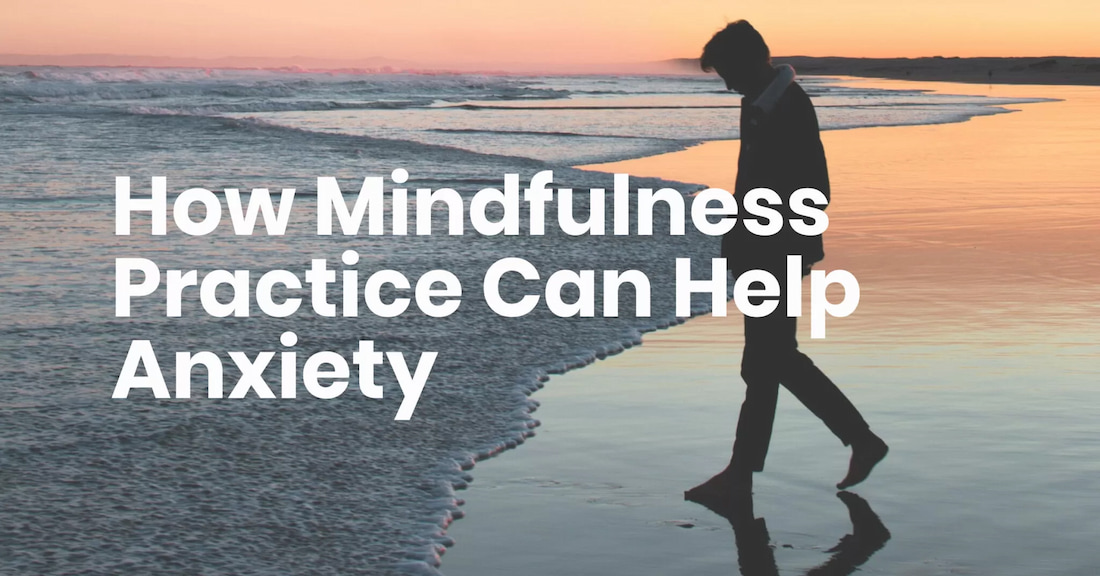
How mindfulness practice can help anxiety
Many of us live fast paced, stressful lives that can seem like we’re running from the beginning of the week to the end, without pausing to reflect or spend time doing the things that nourish us.
Juggling work or study (or both), family lives, relationships, friendships and all the admin that life brings is time consuming and often fraught with angst and worry that we’re not fulfilling each role enough. So, it’s little wonder that almost three quarters of UK adults have “felt so stressed at some point over the last year that they felt overwhelmed or unable to cope”. [1]
Running alongside this high level of stress is a high level of anxiety, with 1 in 6 people experiencing a common mental health problem such as anxiety, in any given week. [2]
Anxiety can be overwhelming and if it’s combined with panic attacks, can be very frightening. If you’re struggling with anxiety, or any other mental health problem, speaking to your GP, a psychotherapist, counsellor or other mental health specialist can put you on the right path to finding help. You can also call the Samaritans free on 116 123 any time of day.
Anxiety can also be helped by practicing mindfulness. Here’s how being more mindful and present can be helpful for managing the symptoms of anxiety.
What is anxiety?
We may all feel worried at times, for example if we have a job interview looming or a social event we have to attend that we’re nervous about.
But sometimes, these feelings of unease, worry, fear and panic can be present more often than not and we find it can be difficult to control them, meaning that they affect our daily lives. This is anxiety.
Generalised Anxiety Disorder, or GAD, is the term used to describe feeling anxious most days for known or unknown reasons and finding it difficult or impossible to switch off and relax. Those with generalised anxiety feel worried, restless and constantly on edge, and often describe feeling like they’re running on nervous energy. It can also cause trouble sleeping and concentrating along with dizzy spells and a racing heart.
Anxiety can be experienced alongside panic attacks, phobias such as agoraphobia (the fear of being in a situation or place we couldn’t escape from if we wanted to), post-traumatic stress disorder (PTSD) and social anxiety disorder (the fear of being in a social situation).
Talking therapies such as cognitive behavioural therapy or CBT can be helpful for managing anxiety. [3]
However, we can also help to manage our anxiety ourselves, either on its own or alongside therapy and medication if required – and that’s with mindfulness.
What is mindfulness?
It’s perhaps useful to begin with what mindfulness isn’t – it isn’t (necessarily) sitting cross legged at the top of a mountain, breathing deeply with a completely empty mind devoid of all thoughts.
Mindfulness can, of course, be this. But this imagined utopia of serenity and mind emptying can be damaging as it can make us frustrated that we’re not achieving this level of deep meditation and actually cause our anxiety to feel worse. It can take many, many years of practice to achieve this zen like state. Most of us, with practice, can find the space to relax and accept the thoughts and feelings that flow through.
Mindfulness is described by Professor Mark Williams, former director of the Oxford Mindfulness Centre, as “knowing directly what is going on inside and outside ourselves, moment by moment”.
It means being present and aware of the here and now, how our body feels, how our mind feels and what’s going on in our external environment, from the temperature to the sights and smells. Mindfulness also means being in the moment – at the moment you’re practicing, attachments and problems have faded away – all there is, is that moment.
How to practice mindfulness
Mindfulness can be practised anywhere at any time of day, but it’s best to sit somewhere quiet and comfortable with no distractions. Sit comfortably with a straight back, either on a chair or on a cushion on the floor.
Place your hands in your lap and close your eyes. Take slow, purposeful, deep breaths in through your nose and out through your mouth. With each breath, focus on how your whole body feels with the air entering and exiting. When thoughts enter your mind, acknowledge it and then allow it to move on by. Allow yourself to be a bystander of your own thought parade. You can bring this thought process into your day to day life, like if you find your mind is crowded before going to sleep. Simply acknowledge the thought, recognise that it isn’t serving you to do what you need to do right now (sleep) and let it go.
There are numerous apps available that provide guided mindfulness meditation exercises. Guided meditations are a useful way to begin the practice of mindfulness as they gently remind us to keep focusing on our breath and allowing thoughts to come and go.
Mindfulness can also be practiced when we’re eating or walking about. Taking notice of the taste, texture, smell and feeling of each bite or the sensations of our body as it moves. We can also be mindful by sitting quietly and noticing the sounds around us and those that are further away. Or with our eyes open, taking a slow moment to take note of our surroundings or admire the beauty and perfection of each piece of nature you see, whether it be trees you notice, the sound of birds or a bumblebee hovering around.
How mindfulness can help anxiety
Studies show that mindfulness can help anxiety, such as this one that found that it’s a “promising treatment for anxiety and mood problems”. [4] Another study found that mindfulness may also improve stress levels alongside improving anxiety. [5]
Living a more mindful life can significantly benefit us if we’re struggling with anxiety as it helps us respond to life in a more aware manner, rather than acting instinctively whilst unaware of the emotions that might be influencing us. We can adapt to stressful or anxiety-inducing events, and approach them whilst processing our thoughts and feelings calmly and logically.
The simple act of stopping, breathing and being aware of our body can be enough to calm a racing heart and rapid breathing. If you notice your breathing rate or heart rate is increasing, simply acknowledge it and focus on taking some slow breaths into your diaphragm so that when you breathe in, you push your tummy out and when you breathe out your tummy goes back in.
We may also take fewer things for granted if we’re making a point of being aware of all the things that surround us. It takes us off autopilot, and helps us to look at things with a fresh perspective.
If you’re struggling with anxiety, know that you’re not alone. Taking some time each day to be mindful can help to calm your busy mind and is well worth a try.
References
1) Mental Health Foundation. 2022. Stressed nation: 74% of UK ‘overwhelmed or unable to cope’ at some point in the past year. [Accessed 10 March 2022].
2) Mind. 2022. Mental health facts and statistics. [Accessed 10 March 2022].
3) Strawn, J. R., Geracioti, L., Rajdev, N., Clemenza, K., & Levine, A., 2018. Pharmacotherapy for generalized anxiety disorder in adult and paediatric patients: an evidence-based treatment review. Expert opinion on pharmacotherapy, 2018, 19(10), 1057–1070 [Accessed 10 March 2022].
4) Hofmann, S. G., Sawyer, A. T., Witt, A. A., & Oh, D., 2010. The effect of mindfulness-based therapy on anxiety and depression: A meta-analytic review. Journal of consulting and clinical psychology, 2010, 78(2), 169–183 [Accessed 10 March 2022].
5) Hoge, E. A., Bui, E., Marques, L., Metcalf, C. A., Morris, L. K., Robinaugh, D. J., Worthington, J. J., Pollack, M. H., & Simon, N. M., 2013. Randomized controlled trial of mindfulness meditation for generalized anxiety disorder: effects on anxiety and stress reactivity. The Journal of clinical psychiatry, 2013, 74(8), 786–792 [Accessed 10 March 2022].


